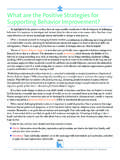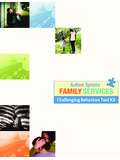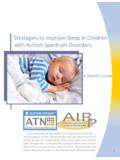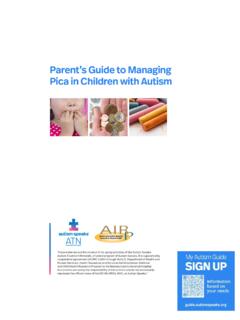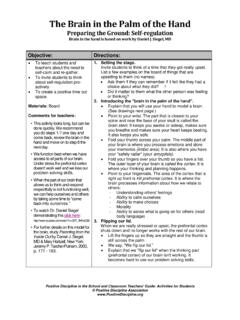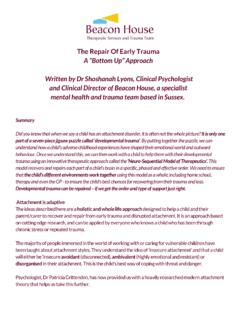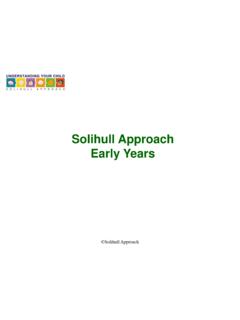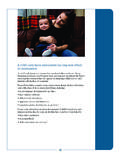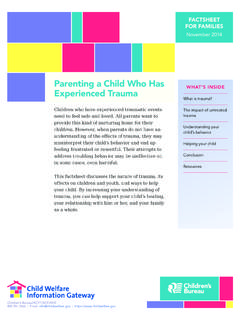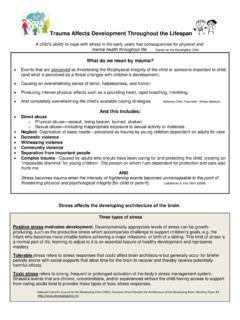Transcription of 2017 - Autism Speaks
1 Autism AND HEALTH: A SPECIAL REPORT BY Autism Speaks . Advances in Understanding and Treating the Health Conditions that Frequently Accompany Autism 2017. Autism AND HEALTH: A SPECIAL REPORT BY Autism Speaks . Advances in Understanding and Treating the Health Conditions that Frequently Accompany Autism 2017. TABLE OF CONTENTS. Introduction 1. Autism and Epilepsy 2. Autism and GI Disorders 4. Autism and Disrupted Sleep 8. Autism and Feeding/Eating Issues 10. Autism and Mental Health 14. Autism and Premature Death 21. Resources on Autism and Health 22. Supplement: What We Know About Autism in Facts and Figures 24. The following information is solely for educational purposes. It should not be construed as medical advice nor a substitute for medical care. Please consult a physician for personalized guidance about care and treatment.
2 Editor's note: Whenever possible, the scientific citations in this report link to open-access, full-text articles. 2017 Autism Speaks Inc. Autism Speaks and Autism Speaks Design are registered trademarks owned by Autism Speaks Inc. All rights reserved. The use of unaffiliated representatives for endorsement, advertising, promotional and sales material is prohibited by law. INTRODUCTION. Autism is a spectrum disorder meaning it has many forms that affect people in a variety of ways and in varying degrees. Each person's experience with Autism presents unique challenges, as well as strengths, which define the type of support needed to lead a fulfilling life. The facts and figures on the following pages help us better understand the complex and diverse effects of Autism on people living with the condition, their families and our nation as a whole.
3 In particular, this year's special report dives deeply into the latest research on the physical and mental health conditions that frequently accompany Autism . We now know, beyond doubt, that for many people, Autism is a whole-body disorder. (Bolton 2009, Croen 2015). Its frequent co-morbidities include seizures, gastrointestinal disorders, sleep disturbances, eating and feeding challenges, attention deficit and hyperactivity disorder (ADHD), anxiety, depression, schizophrenia and bipolar disorder. These issues can extend across the life span. They also contribute to an alarming rate of premature death among those with Autism . Of the studies examining this troubling issue, the most recent found the average life span of someone with Autism to be half that of the general population an average of 36 versus 72 years.
4 (Guan 2017). Autism itself is not a cause of premature mortality. Rather, research suggests that it relates to many of the medical and mental health conditions in this report, most of which are treatable and some . such as obesity, depression and anxiety potentially preventable with greater understanding and support. Autism itself is not a cause of premature mortality. Rather, it relates to many of the medical and mental health conditions in this report most of which are treatable and/or preventable. Today, genetic research is delving into the biological causes of Autism -associated health conditions. This is part of a new avenue of Autism research aimed at identifying the many biological subtypes of Autism and developing personalized treatments and supports. Meanwhile, specialists at leading Autism care centers are working with patients and their families to improve the health and quality of life of all those with Autism by developing and disseminating evaluation and treat- ment guidelines for healthcare providers.
5 (Perrin 2012 , Warfield 2016) This effort also includes Autism -specific medical education and teleconferencing programs to share expertise. (Mazurek 2017). These programs have helped produce a sea change in Autism awareness and treatment capabilities among the pediatricians, family physicians and other non-specialists who provide the bulk of healthcare to the nation's estimated 3 million people on the Autism spectrum. The purpose of this special report is to summarize the latest understanding of Autism 's commonly associated physical and mental health conditions, including how best to identify, treat and in some cases prevent them to improve overall health and quality of life. 1. Autism AND EPILEPSY (seizure disorder). Epilepsy affects a fifth to a third (20 to 33 percent) of people who have Autism , compared to an estimated 1 to 2 percent of the general population.
6 Epilepsy, or seizure disorder, was the first medical condition clearly connected to Autism . (Gubbay 1970) This association provided early evidence that Autism is a neurodevelopmental (affecting brain development). condition and helped put to rest false theories relating Autism to emotionally cold parenting . Overall, epilepsy affects a fifth to a third (20 to 33. percent) of people who have Autism , compared to an estimated 1 to 2 percent of the general population. (Spence 2009) The Autism -epilepsy overlap appears to be most common among people who also have intellectual disability. (Amiet 2008) Intellectual disability defined as an IQ score below 70 along with challenges in every- day function affects an estimated 32 percent of those who have Autism . (Christensen 2016). Identifying and effectively treating epilepsy in those with Autism is critically important, given the potential for brain damage and death from uncontrolled seizures.
7 In a 2012 review of 21. studies, researchers found that epilepsy was the reported cause of death for 7 to 30 percent people with Autism . (Woolfenden 2012) In addition, a review of studies on children with Autism , epilepsy and sleep disorders suggests a vicious cycle with uncontrolled seizures affecting sleep and disrupted sleep increasing seizures. (Malow 2004). A review of 21 studies found epilepsy to be the cause of death in 7 to 30 percent of people affected by Autism . While the association between epilepsy and Autism is well known, diagnosis can be challenging because seizures are not always outwardly evident, and many people with Autism have difficulty recognizing and communicating their symptoms. RECOGNIZING EPILEPSY IN SOMEONE WITH Autism . Seizures can begin at any age, though research has identified two peaks in onset among children with Autism in the preschool years and again in adolescence.
8 (Rossi 2000). Characteristic symptoms include: Unexplained staring spells Stiffening of muscles Involuntary jerking of limbs 2. Other less-specific symptoms can include: Sleepiness or sleep disturbances Marked and unexplained irritability or aggressiveness Regression in normal development Like Autism , epilepsy is a spectrum disorder. Severity varies widely. In addition, experts now distinguish seizures by where they begin in the brain important because it affects the choice of seizure medication, the potential benefit of epilepsy surgery, outlook and possible causes. (Fisher 2017). DIAGNOSING AND TREATING EPILEPSY IN THOSE AFFECTED BY Autism . Suspicion of seizures warrants prompt evaluation by a neurologist, who may order an electroencephalogram (EEG), a noninvasive process that involves placing electrodes on the head to monitor activity in the brain .
9 By analyzing EEG patterns, the neurologist can identify seizures and other altered brain activity of concern. Often patients who have Autism need EEG protocols that address their sensory and communication challenges. (Katz 2015) (See resource section for more information on Autism -friendly EEG. procedures.). Treating epilepsy in patients who have Autism follows the same principles as treatment of epilepsy in others. Typically, the physician selects an anti-epileptic drug based on several consider- ations such as the type and severity of seizures and their associated EEG patterns. Though anti-epileptic drugs do not cure epilepsy, in most cases they can prevent or minimize seizures. After starting a medication, the neurologist works with the patient and/or his family to monitor effectiveness and side effects.
10 Common side effects include mild fatigue, abdominal discomfort or dizziness. To minimize side effects, the doctor may start medications at a low dose and slowly increase it. Dosage adjustments are common to find an optimal dose and maintain good control of seizures over time. Epilepsy drugs eliminate seizures in around two-thirds of patients. More difficult-to-control seizures sometimes respond to combinations of two or more medications. When medications fail to control seizures, physicians and families can discuss other options. These include vagus nerve stimulation, a technique that prevents seizures by sending pulses of electrical energy to the brain through a device that acts like a pacemaker for the brain . Another option is the surgical removal of seizure-producing areas of the brain .
